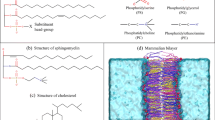Abstract
In order to address the concerns about the applicability of the continuum theory of lipid bilayers, we generalize it by including a film with uniaxial dielectric properties representing the polar head groups of the lipid molecules. As a function of the in-plane dielectric constant \( \kappa_{{\Vert}}^{}\) of this film, we encounter a sequence of different phases. For low values of \( \kappa_{{\Vert}}^{}\) , transmembrane pores have aqueous cores, ions are repelled by the bilayer, and the ion permeability of the bilayer is independent of the ion radius as in the existing theory. For increasing \( \kappa_{{\Vert}}^{}\) , a threshold is reached --of the order of the dielectric constant of water-- beyond which ions are attracted to the lipid bilayer by generic polarization attraction, transmembrane pores collapse, and the ion permeability becomes sensitively dependent on the ion radius, results that are more consistent with experimental and numerical studies of the interaction of ions with neutral lipid bilayers. At even higher values of \( \kappa_{{\Vert}}^{}\) , the ion/pore complexes are predicted to condense in the form of extended arrays. The generalized continuum theory can be tested quantitatively by studies of the ion permeability as a function of salt concentration and co-surfactant concentration.
Similar content being viewed by others
References
A. Parsegian, Nature 221, 844 (1969); J.P. Dilger, S.G.A. McLaughlin, T.J. McIntosh, S.A. Simon, Science, 206, 1196 (1979).
Continuum theory overestimates the Born barrier for small ions because it does not properly include the energy cost associated with the loss of the hydration shell when an ion is placed in a lipid environment.
A. Finkelstein, Water Movement Through Lipid Bilayers, Pores, and Plasma Membranes: Theory and Reality (Wiley Interscience, New York, 1987).
R. Benz, P. Läuger, Biochem. Biophys. Acta 468, 245 (1977).
H. Hauser, D. Oldani, M.C. Phillips, Biochemistry. 12, 4507 (1973).
C. Taupin, M. Dvolaitzky, C. Sauterey, Biochemistry, 14, 4771 (1975); J.F. Nagle, H.L. Scott, Biochim. Biophys. Acta 513, 236 (1978).
S. Paula, A.G. Volkov, A.N. Van Hoek, T.H. Haines, D.W. Deamer, Biophys. J. 70, 339 (1996).
F. Bordi, C. Cametti, A. Naglieri, Biophys. J. 74, 1358 (1998).
M. Pavlin, D. Miklav, Bioelectrochemistry. Epub (2008).
V. Knecht, S.J. Marrink, Biophys. J. 92, 4254 (2007).
A.A. Gurtovenko, O.I. Onike, J. Anwar, Langmuir. 24, 9656 (2008).
A charge q in an aqueous medium with dielectric constant ϰ W near a dielectric slab with dielectric constant ϰ L is subject to a repulsive image-charge interaction with an effective image-charge q(κ W−ϰ L / ϰ L+ϰ W).
S.A. Tatulian, Eur. J. Biochem. 170, 413 (1987); the binding energy follows a Hofmeister Series (e.g., monovalent anions bind to DPPC with binding affinities that can be ordered as NO3− < I− < SCN− < ClO4−).
L.J. Lis, V.A. Parsegian, R.P. Rand, Biochemistry. 20, 1761 (1981); L.J. Lis, W.T. Lis, V.A. Parsegian, R.P. Rand, Biochemistry 20, 1771 (1981).
R. Zidovetzki, A.W. Atiya, H. De Boeck, Membr. Biochem. 8, 177 (1989).
J.R. Rydall, P.M. Macdonald, Biochemistry 31, 1092 (1992).
J. Sachs et al., Biophys. J. 86, 3772 (2004).
A. Raudino, D. Mauzerall, Biophys. J. 50, 441 (1986).
H.A. Stern, S.E. Feller, J. Chem. Phys. 118, 3401 (2003).
H. Nymeyer, H.X. Zhou, Biophys. J. 94, 1185 (2008).
O.S. Andersen, Membrane Transport in Biology, edited by G. Giebish, Vol. I (Springer, New York, 1978), p. 349.
For a discussion: P. Shuskov et al., Langmuir 24, 4615 (2008).
U. Kaatze et al., J. Phys. Chem. 89, 2565 (1989).
P. Yeagle, Acc. Chem. Res. 11, 321 (1978).
L. Hari, A.E. Mark, S.-J. Marrink, Biophys. J. 92, 4209 (2007).
A.A. Gurtovenko, I. Vattulainen, J. Am. Chem. Soc. 127, 17570 (2005); Biophys. J. 92, 1878 (2007).
NMR studies such as those of D.I. Semchyschyn, P.M. Macdonald, Magn. Res. Chem. 42, 89 (2004) indicate that charges imbedded in lipid bilayers can alter the angle between the head group and the layer normal. This is an important non-linear effect not included in the present description.
This is obtained from the capacitive self-energy of a charged prolate ellipsoidal conductor given in L. Landau, E. Lifshitz, Electrodynamics of Continuous Media (Pergamom, Oxford, 1975), Eq. 4.18, and then relating this result to the self-energy of a charged spherical conductor placed in a uniaxial dielectric medium by simple scaling arguments.
Numerical simulations of cations associating with neutral lipid bilayers report a peak in the density profile at the water/lipid-head-group interface: A. Cordomi, O. Erdholm, J. Perez, J. Phys. Chem. 112, 1401 (2008).
W. Helfrich, Phys. Lett. A 50, 115 (1974).
F.Y. Jiang, Y. Bouret, J.T. Kindt, Biophys. J. 87, 182 (2004).
J. Zhang, A. Kamenev, B.I. Shklovskii, Phys. Rev. Lett. 95, 148101 (2005).
A. Kamenev, J. Zhang, A.I. Larkin, B.I. Shklovskii, Physica A 359, 129 (2006).
F.Y. Jiang, Y. Bouret, J.T. Kindt, Biophys. J. 87, 182 (2004).
P.H. Puech, N. Borghi, E. Karatekin, F. Brochard-Wyart, Phys. Rev. Lett. 90, 128304 (2003).
E.J. Mele, Am. J. Phys. 69, 557 (2001).
B. Neumcke, P. Lauger, Biophys. J. 9, 1160 (1969).
A.V. Finkelstein, D.N. Ivankov, A.M. Dykhne, http://eprintweb.org/S/authors/All/iv/Ivankov/5.
Author information
Authors and Affiliations
Corresponding author
Rights and permissions
About this article
Cite this article
Gerami, R., Bruinsma, R.F. Continuum theory of lipid bilayer electrostatics. Eur. Phys. J. E 30, 197–204 (2009). https://doi.org/10.1140/epje/i2009-10519-2
Received:
Revised:
Accepted:
Published:
Issue Date:
DOI: https://doi.org/10.1140/epje/i2009-10519-2




